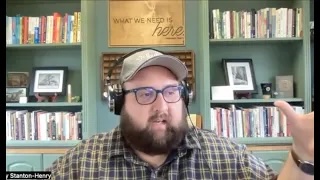A few years ago I toured the northern English countryside where George Fox started the preaching that grew into the Quaker movement, and I quickly noticed a pattern. The van would pull up to the site of an old church and our tour guide would turn around to point to the nearby high spot where Fox had preached. On Firbank Fell, Fox climbed a rock embankment behind the church. In Sedbergh, he declared “the everlasting Truth” from atop a bench underneath a yew tree in the “steeple-house yard.” As Friends settled down, acquired real estate, and moved indoors, Fox’s fondness for unconventional pulpits was institutionalized in buildings modeled after barns and called meetinghouses—a purposefully anti-church style they brought with them to the North American colonies.
The beauty of that style is captured by Jean Schnell’s photographic essay that begins this issue. Over the past few years Jean has criss-crossed New England to painstakingly chronicle the beauty of form and material in the minimalism of its old meetinghouses. Plainness never looked more breathtaking.
It’s easy to get swept away. The danger in such beauty and attachment is that our buildings can become the objects of our attention. Many of our older meetinghouses were built for populations that moved away generations ago, and the congregations who remain expend much of their energies on maintaining historic buildings that are barely used for an hour or two a week. It’s not unusual to find a meetinghouse built for hundreds that only sees a few dozen worshipers on First Day.
Chris Mohr and Lynne Calamia highlight the adaptive reuse of two Philadelphia meetinghouses in neighborhoods that have been fractured by highway projects and mid-twentieth-century urban blight. The Race Street and Arch Street meetinghouses have been largely reinvented as visible Quaker presences in the city. Beth Henricks shows how Friends Committee on National Legislation continues to create a space for welcome and Quaker witness within walking distance of elected officials.
It was never the point that Quaker spaces had to be achingly pretty or situated on prime real estate, of course. Cherice Bock evokes a Friends church on the other side of the continent, far from East Coast quaintness. It has worn carpet, dark pews, stained glass, and a color combination whose popularity didn’t outlast the 1970s. But it also has a congregation that is intentional about opening itself up to the community. A walking trail, shared meals, and clothing swaps are just a few of the everyday ministries taking place.
Still, it’s hard not to miss Fox’s hillside. Lola Georg brings us full circle to remind us tenderly that Quaker worship can still happen anywhere: in homes, in protest camps, in meetinghouses. And, yes, under trees.
Old-time Quakers used to talk of opportunities, moments in the everyday world where Friends might unexpectedly find themselves with a space for worship. These impromptu gatherings make the whole world into a Quaker space. As we enter the crescendo of the U.S. election campaign and absorb the shock and horror of successive shootings and long-burning injustices, my prayer is that we can keep reaching beyond our meetinghouse walls to find more of these opportunities and to boldly preach the truths we are given.




Comments on Friendsjournal.org may be used in the Forum of the print magazine and may be edited for length and clarity.